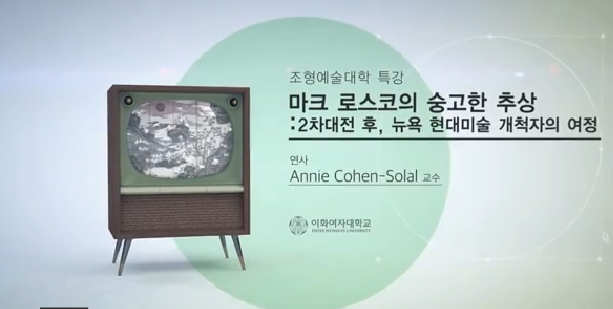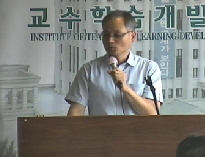The purpose of this study is to examine the aspects of sublimity found in Namdosaram and Bihwamilgyo and consider the effects of them. Namdosaram is focused on the idea of ‘sound of which words correspond to life’, and Bihwamilgyo is on the abstra...
http://chineseinput.net/에서 pinyin(병음)방식으로 중국어를 변환할 수 있습니다.
변환된 중국어를 복사하여 사용하시면 됩니다.
- 中文 을 입력하시려면 zhongwen을 입력하시고 space를누르시면됩니다.
- 北京 을 입력하시려면 beijing을 입력하시고 space를 누르시면 됩니다.

이청준 소설에 나타난 비가시적 세계의 숭고 -『남도사람』과 『비화밀교』를 중심으로- = Sublimity of The invisible world in Lee Cheong-jun`s Novels -Focusing on Namdosaram and Bihwamilgyo-
한글로보기https://www.riss.kr/link?id=A101758498
- 저자
- 발행기관
- 학술지명
- 권호사항
-
발행연도
2015
-
작성언어
-
-
주제어
숭고 ; 그로테스크 ; 양가감정 ; 비가시의 세계 ; 용서 ; 암시 ; sublimity ; grotesque ; ambivalence ; the invisible world ; forgiveness ; suggestion
-
KDC
700
-
등재정보
KCI등재
-
자료형태
학술저널
-
수록면
143-164(22쪽)
-
KCI 피인용횟수
1
- 제공처
-
0
상세조회 -
0
다운로드
부가정보
다국어 초록 (Multilingual Abstract)

The purpose of this study is to examine the aspects of sublimity found in Namdosaram and Bihwamilgyo and consider the effects of them. Namdosaram is focused on the idea of ‘sound of which words correspond to life’, and Bihwamilgyo is on the abstraction of the invisible world. In brief, these two texts are commonly focused on the object to be presented rather than that to be reproduced. The form of ‘a lump of the sun’ in Namdosaram combines contrastive and heterogeneous elements and arouses contradictory emotion. In addition, brutality of the father who is a singer overthrows the logic of reality. Bihwamilgyo embodies the invisible world into ‘a secret ritual’. In this ritual, ``I`` hears the loud chorus and feels a thrill and terror, and that emotion gets transferred to noble sentiment with the form of a ‘ritual’. The Horse that is Reborn, the ending of Namdosaram series, the writer resolves the irony of ambivalence and finishes the sentiment of the work as sublimity. Also, in Bihwamilgyo, he embodies secret ‘explosion’ and ends with grotesqueness. Considering explosion is ‘tragedy’, we can see that what the writer values here is ‘forgiveness’ and ‘suggestion’ taking the principle of moderation and balance. In Lee Cheong-jun’s works, grotesque elements are adopted often, but they function as a means to elevate sublimity emotion after all.
참고문헌 (Reference)
1 진중권, "현대미학강의" 아트북스 2013
2 미하일 바흐찐, "프랑수아 라블레의 작품과 중세 및 르네상스의 민중문화" 아카넷 2001
3 장윤수, "텍스트 생산의 담론 구조, 이청준의 <비화밀교>" 한국현대소설학회 (27) : 1-12, 2005
4 김병익, "전망을 위한 성찰" 문학과 지성사 308-323, 1987
5 김현, "이청준 깊이읽기" 문학과지성사 1999
6 권택영, "이청준 깊이 읽기" 문학과 지성사 1999
7 성민엽, "이청준 깊이 읽기" 문학과 지성사 1999
8 존 버거, "어떻게 볼 것인가" 현대미학사 1995
9 박영준, "알레고리스트의 위치와 「비화밀교」의 정치성" 한민족문화학회 (36) : 333-360, 2011
10 에드먼드 버크, "숭고와 미의 근원을 찾아서-쾌와 고통에 대한 미학적 탐구" 한길사 2010
1 진중권, "현대미학강의" 아트북스 2013
2 미하일 바흐찐, "프랑수아 라블레의 작품과 중세 및 르네상스의 민중문화" 아카넷 2001
3 장윤수, "텍스트 생산의 담론 구조, 이청준의 <비화밀교>" 한국현대소설학회 (27) : 1-12, 2005
4 김병익, "전망을 위한 성찰" 문학과 지성사 308-323, 1987
5 김현, "이청준 깊이읽기" 문학과지성사 1999
6 권택영, "이청준 깊이 읽기" 문학과 지성사 1999
7 성민엽, "이청준 깊이 읽기" 문학과 지성사 1999
8 존 버거, "어떻게 볼 것인가" 현대미학사 1995
9 박영준, "알레고리스트의 위치와 「비화밀교」의 정치성" 한민족문화학회 (36) : 333-360, 2011
10 에드먼드 버크, "숭고와 미의 근원을 찾아서-쾌와 고통에 대한 미학적 탐구" 한길사 2010
11 김예령, "숭고에 대하여" 문학과지성사 2005
12 이청준, "비화밀교" 나남 1985
13 유철상, "복수와 해방의 변증법적 화해 : 이청준의 「언어사회학 서설」연작을 중심으로" 현대문학이론학회 16 : 197-214, 2001
14 볼프강 카이저, "미술과 문학에 나타난 그로테스크" 아모르문디 2011
15 롱기누스, "롱기누스의 숭고미 이론" 연세대 출판부 1-148, 2002
16 장파, "동양과 서양, 그리고 미학" 푸른숲 1999
17 임철규, "눈의 역사 눈의 미학" 한길사 2004
18 이청준, "남도사람" 문학과비평사 1988
19 박슬기, "그로테스크 미학의 존재론적 기반과 의의" 인문학연구원 (58) : 177-202, 2007
20 필립 톰슨, "그로테스크" 서울대 출판부 1986
동일학술지(권/호) 다른 논문
-
사진 일기와 그림 동화 개작을 통한 자기발견과 그 효능
- 겨레어문학회
- 노영윤 ( Young Yun Noh )
- 2015
- KCI등재
-
신문 표제의 공정성 고찰 -『조선일보』와 『한겨레』기사를 중심으로-
- 겨레어문학회
- 변영수 ( Young Su Byun )
- 2015
- KCI등재
-
설화 < 친자식보다 나은 양아들 >에 나타난 가장(家長)의 소외 문제와 주체성 회복의 과정
- 겨레어문학회
- 손영은 ( Young Eun Son )
- 2015
- KCI등재
-
- 겨레어문학회
- 이미나 ( Mi Na Lee )
- 2015
- KCI등재
분석정보
인용정보 인용지수 설명보기
학술지 이력
| 연월일 | 이력구분 | 이력상세 | 등재구분 |
|---|---|---|---|
| 2028 | 평가예정 | 재인증평가 신청대상 (재인증) | |
| 2022-01-01 | 평가 | 등재학술지 유지 (재인증) |  |
| 2019-01-01 | 평가 | 등재학술지 유지 (계속평가) |  |
| 2016-01-01 | 평가 | 등재학술지 선정 (계속평가) |  |
| 2015-12-01 | 평가 | 등재후보로 하락 (기타) |  |
| 2014-01-09 | 학술지명변경 | 외국어명 : 미등록 -> Journal of Korean National Language and Literature |  |
| 2011-01-01 | 평가 | 등재학술지 선정 (등재후보2차) |  |
| 2010-01-01 | 평가 | 등재후보 1차 PASS (등재후보1차) |  |
| 2009-01-01 | 평가 | 등재후보 1차 FAIL (등재후보1차) |  |
| 2008-01-01 | 평가 | 등재후보학술지 유지 (등재후보1차) |  |
| 2006-01-01 | 평가 | 등재후보학술지 선정 (신규평가) |  |
학술지 인용정보
| 기준연도 | WOS-KCI 통합IF(2년) | KCIF(2년) | KCIF(3년) |
|---|---|---|---|
| 2016 | 0.44 | 0.44 | 0.49 |
| KCIF(4년) | KCIF(5년) | 중심성지수(3년) | 즉시성지수 |
| 0.44 | 0.48 | 1.059 | 0 |




 KCI
KCI KISS
KISS






